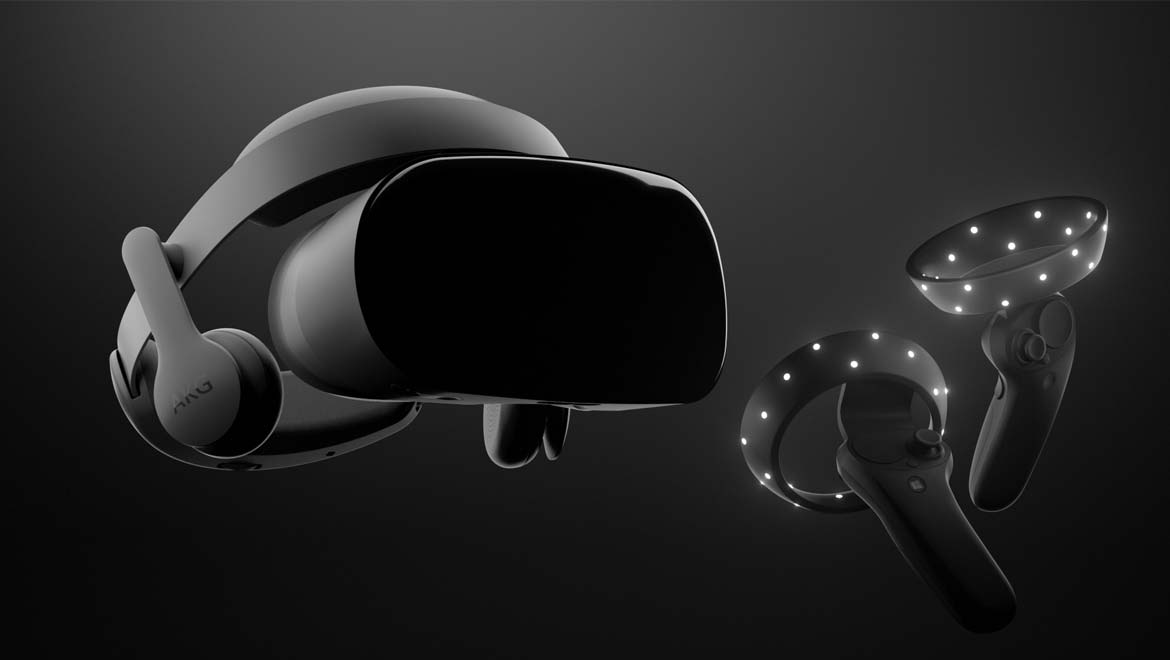Many of us already enjoy VR for gaming and recreational activities. However, Microsoft would also be happy if you expanded that use to interfacing with your computer desktop, connecting with colleagues far away in the same virtual space, and… yet more immersive gaming. They have partnered with Samsung to deliver a new generation of computing in hybrid real-life/virtual spaces. They call it Mixed Reality, and have premiered it in an event earlier this month. Microsoft claim that their Mixed Reality – which will require a new form of headset to run it – will help individuals and companies to enjoy new dimensions of creativity, collaboration and competition.
Creative workspace
Alex Kipman, a Technical Fellow at Microsoft, showcased a number of features we may stand to expect from Mixed Reality when it is released on the 17th of October 2017. These include its new style of desktop, which appears as a ‘creative workspace’ which displays pertinent information on screens hung on its ‘walls’. This workspace can be superimposed on an existing, everyday room, and is a part of the upcoming Windows Creators Fall Update for Mixed Reality-enabled hardware. The information you could see on the ‘walls’ of this style of desktop is along the lines of what Cortana on your current desktop can offer: weather updates, scheduling information and editing, search results and other results of interaction with the popular assistant software.
Mixed Reality can also enhance video conferencing by generating shared spaces in which the quasi-life-sized avatars of numerous colleagues can meet, talk and share information. These avatars can match the gestures and body language of the operator to a degree, by using the Mixed Reality hardware’s built-in dual controls, one for each hand. This has been achieved by Microsoft’s acquisition of Altspace VR, a company that already offers virtual meeting and conferencing solutions. Therefore, some business-oriented customers may also have some familiarity with Mixed Reality’s approach to communicating across distances.
More about the Mixed Reality Computer
This setup takes the form of a headset that requires a connection to a PC with a relatively recent Intel or AMD processor with either integrated or discrete graphics to run. For example, the Samsung HMD Odyssey, the ‘flagship’ headset introduced alongside Microsoft Mixed Reality, requires a four-core processor such as a sixth-generation Intel i5 or a 4.2GHz AMD FX-4350 to power the immersive experience at 90 frames per second. This is known as ‘Windows Mixed Reality (WMR) Ultra’, and is the more ‘high-performance’ profile of the new form of computing. Alternatively, you can use a dual-core processor along the lines of a seventh-generation i5 with its own integrated graphics (i.e. at least Intel HD 620) for WMR at 60fps. A PC will also need 8GB of RAM (and 10GB of free hard drive space for the Ultra variant) and either one HDMI port or one DisplayPort at the 1.2 standard or better to run WMR. WMR Ultra also requires Bluetooth 4.0 or better for connectivity, and one powered 3.0 USB port. This port could be type-A or type-C, although type-C ports will need an adapter.
The new Samsung headset itself has two 3.5 AMOLED screens, one for each eye, at a resolution of 1660x1400. Combined with its 110-degree field of view, Samsung claim this will give a convincing, immersive visual experience that is as vivid as its high-end mobile phone screens. The HMD Odyssey looks much like a typical high-end VR headset, except this new version also has dual DOF cameras mounted on the outer ‘face’ of the visor, so as to incorporate facets of the real world in what it shows the user. The headset also comes equipped with AKG headphones, which are described as being able to deliver fully surround-sound. The headset also comes with inbuilt microphones, so as to interact during conferencing or gaming, and also to talk to Cortana. The HMD Odyssey is just one of a range of mixed-reality headsets coming out later this year. For example, Acer and HP are releasing their own branded WMR headsets. Dell’s version will be known as the Visor, and Lenovo’s as the Explorer.
WMR is also directed at gamers of varying interests and intensities. HALO will have a presence on the WMR Store, as will Superhot, Space Pirate Trainer and Arizona Sunshine. WMR users will also be able to play Minecraft in hybrid reality. This should be a big draw for many who game, as this title is also already popular on existing VR gaming ecosystems. Windows also announced that SteamVR developers now have access to the WMR preview for their platform; therefore, WMR may build up a sizeable presence on Steam among its VR-optimised titles. Consumers should also get access to the WMR SteamVR preview sometime soon.
Microsoft is already somewhat established in the virtual computing space, since the release of the HoloLens in 2015. Although this first-generation VR machine was perhaps not as popular as the company may have liked, they have persevered with the ecosystem, and it now has a considerable presence in consumer- and gamer-grade computing. Therefore, they have decided the time to push more people into buying WMR-compatible hardware is now. This updated form of VR is intended to bring more complete immersion into everyday pursuits such as using the desktop or teleconferencing with far-away co-workers. Microsoft’s Mixed Reality is another step towards a future in which holograms and superimposed software objects are a part of normal life for an increasingly large number of people.
Top image: VR Glasses. (Blogs.Microsoft)
References:
Kipman A. The era of Windows Mixed Reality begins October 17. Windows Blogs. 2017. Available at: https://blogs.windows.com/windowsexperience/2017/10/03/the-era-of-windows-mixed-reality-begins-october-17/#z7yBf7yBh67vHC5B.97
Kipman A. Windows Mixed Reality holiday update. Windows Blogs. 2017. Available at: https://blogs.windows.com/windowsexperience/2017/08/28/windows-mixed-reality-holiday-update/#KgZ78dXWOQq8iFYk.97
Samsung. HMD Odyssey - Windows Mixed Reality. Samsung US Website. 2017. Available at: https://www.samsung.com/us/computing/computing-accessories/computers/xe800zaa-hc1us-xe800zaa-hc1us/







No comment